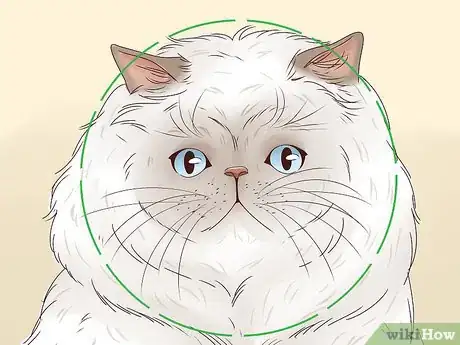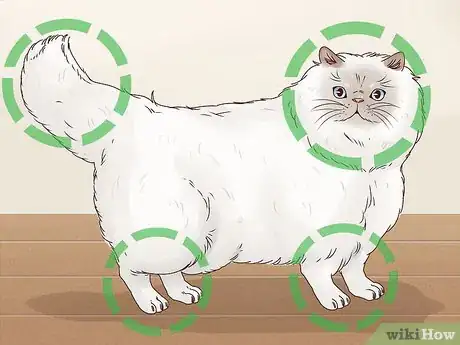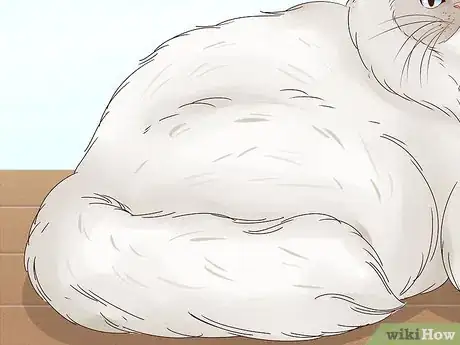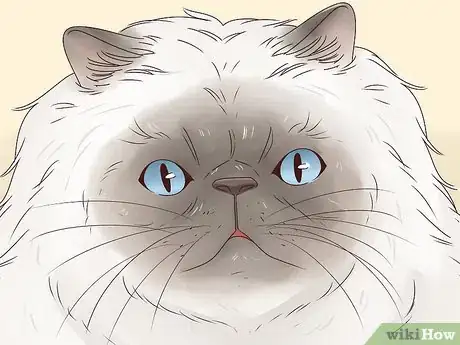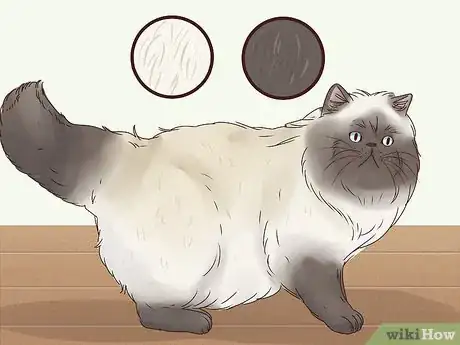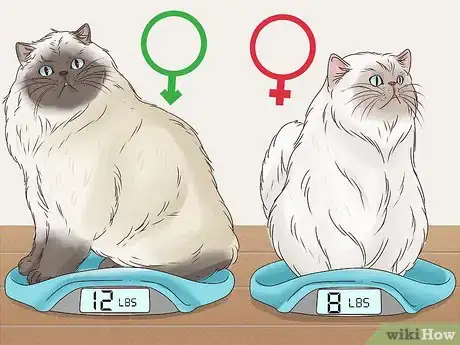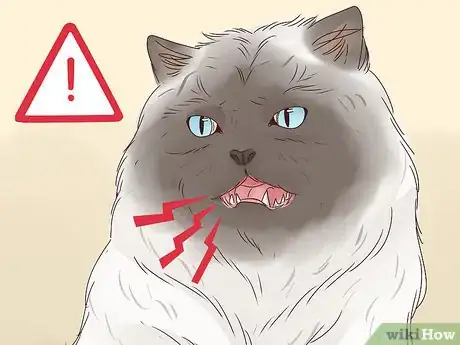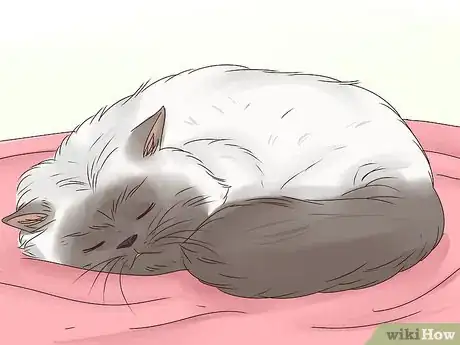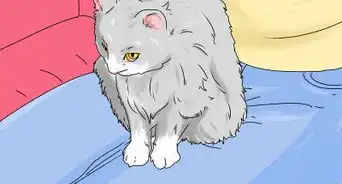This article was co-authored by Pippa Elliott, MRCVS. Dr. Elliott, BVMS, MRCVS is a veterinarian with over 30 years of experience in veterinary surgery and companion animal practice. She graduated from the University of Glasgow in 1987 with a degree in veterinary medicine and surgery. She has worked at the same animal clinic in her hometown for over 20 years.
There are 9 references cited in this article, which can be found at the bottom of the page.
This article has been viewed 31,986 times.
Himalayan cats are a cross between a Persian and a Siamese. Their most defining characteristics are their blue eyes and their long, silky coats. They are docile, affectionate cats that require a lot of attention. To identify this breed, look for rounded and short features, along with the signature blue eyes and white long coat with point colors. Also look for low activity level and a mild personality.
Steps
Identifying Physical Characteristics
-
1Look for round features. Himalayan cats have rounded features. They have a large head that is round in shape. Their eyes are also large and round, and they have full cheeks. Even their ears have rounded tips.[1]
- Himalayan cats also have large, round paws.
-
2Check for short features. In addition to round features, the Himalayan cat also has many short characteristic features. They have a short nose that gives their face a flat look, especially from the side. They have small, short ears. Their necks are short and thick, as are their legs.[2]
- The tail is also short.
Advertisement -
3Notice the long, thick coat. The Himalayan has a very distinctive coat. Their coat is long and thick with a shiny gloss to it. The fur has a soft, fine texture. This long coat covers their entire body. Due to their coat, they have a thick ruff around their neck.[3]
- A Himalayan will have long fur extending down from the front legs and have long tufts of fur in their ears and on their feet.
- They have bushy tails.
-
4Notice the blue eyes. Aside from the long, white, silky coat, the most identifiable characteristic of a Himalayan is their blue eyes. The color blue is vivid and deep. Look for large, round blue eyes.[4]
- The Himalayan cat is a human-made breed that crossed a Persian with a Siamese. One reason they used a Siamese is for the blue eyes.
-
5Look for a white or fawn body with accent colors. A Himalayan cat will mostly be a white or fawn color. Their face, ears, and tail will have an accent color. These accent colors can be just about any color.
- Common accent colors include chocolate, lilac, blue, red, cream tortie, blue-cream, and variations of these shades.
-
6Assess the body size. Himalayans are not small, light cats. They have larger, thicker bodies that are quite solid and stocky. The breed also has large bones. Between this and the thick fur, they look rather large.[5]
- Males can weight over 12 pounds, and females generally range between eight and twelve pounds.
-
7Recognize common medical problems. Himalayans have a few characteristic medical problems. Due to the Himmie’s flat face, they are prone to respiratory problems. This may include trouble breathing, though healthy cats shouldn’t have a problem breathing.[6]
- Neutered Himalayans can develop bladder stones.[7]
Recognizing Behavioral Characteristics
-
1Look for mild-mannered characteristics. Himalayans are quiet, calm cats. They can be quite sedate, and are very affectionate and love sitting in a human’s lap. Though they like to be around their humans, they don’t require a lot of attention and do well alone.[8]
- Himmies like to play, but they do it in their own calm, slow way.
-
2Expect to find the Himalayan on low surfaces. Unlike many cat breeds, Himalayans aren’t big climbers or jumpers. This is due partially to their shorter legs. Instead of jumping onto counters, tall furniture, or cat trees, they stay lower to the ground.[9]
- Himmies prefer to sit on chairs and couches than high shelves or platforms.
-
3Anticipate a low activity level. The Himalayan cat is not an extremely active or energetic cat. Most of the time they are calm and placid, but occasionally they will have bursts of energy. They enjoy playing with different kinds of toys. Mostly, a Himalayan will prefer to be in your lap, doing whatever you’re doing, or napping on the couch.[10]
- Because of this, Himmies do better with older children than younger ones.
- Himalayans like playing fetch. They also enjoy dangling toys and even balled up pieces of paper.
Finding a Himalayan Cat
-
1Find a breeder. If you want to adopt a cat from a breeder, make sure to find a reputable breeder. Reputable breeders will do health certifications to screen for genetic health problems. They also will raise kittens at home and won’t isolate them.[11]
- Start by checking cat breed websites, such as The Cat Fanciers’ Association, The Fanciers Breeder Referral List, and The International Cat Association.
- If you visit breeder websites, watch for red flags. These include immediately available kittens, multiple litters, paying online with a credit card, and your choice of any kitten.
- If you purchase your cat from a breeder, ask for the pedigree papers for the kitten, which will show the lineage of its parents. This documentation will prove that your cat is purebred.
-
2Adopt a Himalayan. Instead of going to a breeder, consider adopting a Himalayan cat. Try Himalayan rescue organizations, such as The Persian and Himalayan Cat Rescue and The Purebred Cat Rescue.
- Try pet adoption websites. Always double check the characteristics of any advertised Himalayan cat to make sure that the cat is in fact a Himalayan.
- You can also check your local shelter.
-
3Be patient. Finding your perfect Himalayan cat may take time. If you are interested in getting a cat from a breeder, be aware that some breeders may not let Himalayans be adopted until they are old enough to start showing their point colors, which may be between nine and twelve weeks.
- Make sure to search all avenues, including adoption or rescue, before deciding on whether you are going to adopt an adult cat or get a kitten from a breeder.
References
- ↑ http://cattime.com/cat-breeds/himalayan-cats#/slide/1
- ↑ http://www.hillspet.com/en/us/cat-breeds/himalayan
- ↑ http://www.petmd.com/cat/breeds/c_ct_himalayan
- ↑ http://cattime.com/cat-breeds/himalayan-cats#/slide/1
- ↑ http://www.hillspet.com/en/us/cat-breeds/himalayan
- ↑ http://www.vetstreet.com/cats/himalayan#health
- ↑ http://pets.webmd.com/bladder-stones-cats
- ↑ http://www.vetstreet.com/cats/himalayan#personality
- ↑ http://www.vetstreet.com/cats/himalayan#overview
About This Article
To identify a Himalayan cat, look for the physical characteristics that define the breed like a large, rounded head with full cheeks. A Himalayan will also have rounded eyes, paws, and even the tips of its ears will be round. In addition to roundness, a Himalayan will have short features including a short nose that makes its face look flat from the side. As for its coat, look for fur that is long and thick with a shiny gloss and a thick ruff around the neck. You should also notice a Himalayan’s deep, blue eyes immediately. For more help from our Veterinary co-author, like how to recognize the behaviors of a Himalayan cat, scroll down!
